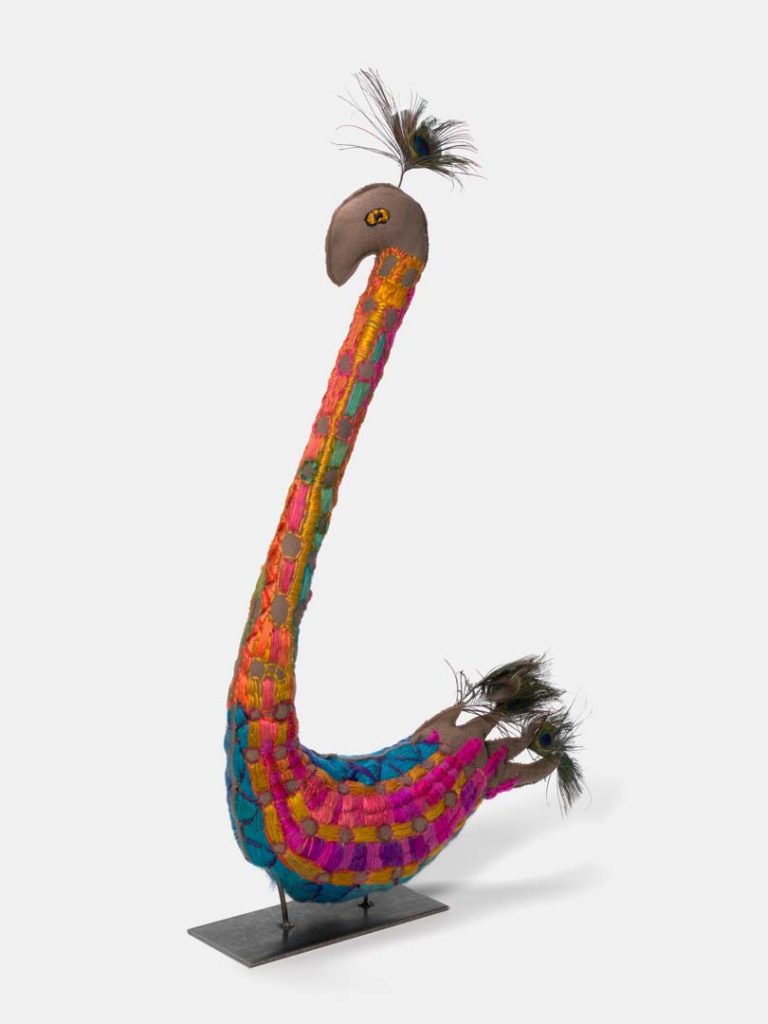We acknowledge the Traditional Owners of the land on which the Queensland Art Gallery | Gallery of Modern Art stands and recognise the creative contribution First Australians make to the art and culture of this country.

Dulcie Sharpe / Luritja/Arrernte peoples / Australia b.1957 / Water bird (rainbow) 2018 / Recycled woollen blankets, natural dye, wool, acrylic yarn and peacock feathers / 98 x 56.5 x 15cm / The Glenn Manser Collection. Purchased 2018 with funds from Glenn Manser through the Queensland Art Gallery | Gallery of Modern Art Foundation / Collection: Queensland Art Gallery | Gallery of Modern Art / © Dulcie Sharpe
Dulcie SharpeWater bird (rainbow) 2018
Not Currently on Display
Yarrenyty Arltere Artists have worked in jewellery, ceramics, textiles, etching, printmaking, animation and film. However, the three main practices of the artists are soft-form sculpture, prints and textiles using recycled materials, natural dyes, stitching, quilting and cyanotype prints.1 Mottled woollen blankets, sourced from second-hand stores, are the base material used for these soft-sculptures. After a process of being hand dyed using local plants, tea and corroded metals, the artists prepare their forms, before delicately embellishing them with intricate and colourful patterns.2
The artists use rich vibrant colours as an act of self-care; the colours are used to provoke joy and happiness in an act of reprieve; all the while tackling inner monologues and the harsh reality of daily life. Dulcie Sharpe’s Water bird (rainbow) stands almost one metre high, with an absurd, almost comical presence. Its exaggerated form, wispy feathers and piercing, highly textured colours are humorous and whimsical. Sharpe’s inspiration for these forms comes from birds that she has witnessed in and around local waterways.
The caricatures, while similar in form — with their elongated necks, short plump bodies, slender heads and beaks, and carefully considered and fashioned crests — have been created with their own specialised personalities and individual markings.
Endnotes:
1. Clotilde Bullen, ‘Dulcie Sharpe’, in Clotilde Bullen, Hetti Perkins and John Barrett-Lennard, Western Australian Indigenous Art Awards 2013 [exhibition catalogue], Art Gallery of Western Australia, Perth, 2013, pp.38–9.
2. Yarrenyty Arltere Artists, ‘Rhonda Sharpe [artist bio]’, <http://www.yarrenytyarltereartists.com/artists/#/rhonda-sharpe/>, viewed November 2018.
Dulcie Sharpe was born at Jay Creek, in the MacDonnell Ranges in the Northern Territory, about 45 kilometres west of Alice Springs. She belongs to the Yarrenyty Arltere Artists, an Indigenous art enterprise in Yarrenyty Arltere, the Larapinta Valley Town Camp.
The not-for-profit art centre was established in 2000, initially as a training program to address chronic social issues faced by families in the town. The centre became an enterprise in 2008 and is now a dynamic hub that plays a vital role in the community as a vehicle for social inclusiveness and economic access.1
The Yarrenyty Arltere Artists are recognised for their vibrant embroidered soft sculptures depicting many facets of life in the desert — from wildlife and customs such as hunting and collecting, to social issues, family life, childcare and intergenerational learning. Sharpe reflects:
I like sewing birds and porcupine [echidna]. I like birds the most. I sew after work, on the weekends and even in hospital. I think too much (a lot) about what sewing to do and what colours for each bird.2
Endnotes:
1. Yarrenyty Arltere Artists, http://www.yarrenytyarltereartists.com/about/, viewed October 2018.
2. Yarrenyty Arltere Artists, ‘Dulcie Sharpe’, http://www.yarrenytyarltereartists.com.au/new-gallery-1, viewed September 2020.
Discussion Questions
1. Look closely at the colours the artist has used to create this sculpture. How many different different colours can you see? Can you name some other birds that are colourful?
2. If you could make a sculpture of your favourite animal, what would you choose? What colours would you include on your sculpture and why?
3. Take a walk around the Queensland Art Gallery and see how many different birds you can find. Sketch each different bird that you see. (Hint: Visit the ‘Open Studio’ in the Pelican Lounge — why do you think this space is called the ‘Pelican Lounge’?)
Activities
1. Imagine you are a bird flying along a creek. What can you see and hear? Describe your surroundings to a friend.
2. Sketch the outline of the waterbird. Add your own patterns and colours to create your own unique design.
3. Dulcie Sharpe’s water bird is made from recycled materials. Collect some colourful found materials and create a soft sculpture of your favourite animal. Think about what kind of personality your animal has and act out a story with a friend that includes both your sculptures.